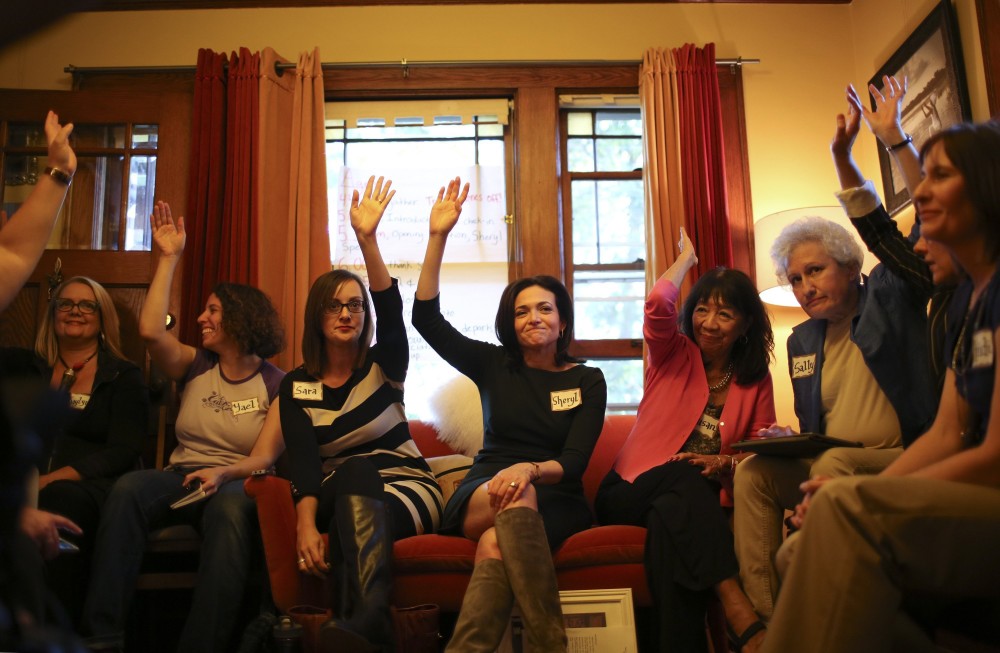By Jerry Large
The Seattle Times.
A few years ago, if you wanted an image to show that women can compete with men in the workplace, you might have picked a photograph of a woman in a snug business suit, wearing red boxing gloves.
Or you might have illustrated women rising in the workplace with a woman, again in a fetching business suit, climbing a ladder. She’d also be wearing high heels, of course.
Unfortunately, images like that are still around in digital archives and they still get used. But there are thousands of better alternatives and many of them are gathered in a new collection of images that avoid trite or stereotypical portrayals of women in favor of more realistic life moments.
The Lean In Collection is a 2-week-old partnership between Getty Images and LeanIn.org, the nonprofit founded by Facebook Chief Operating Officer Sheryl Sandberg to contribute to women’s empowerment.
Getty Images provides illustrations to 2.4 million clients in more than 100 countries. Its customers cover a broad spectrum from advertising and marketing to news media and from large corporations to individual bloggers. Getty is a young company, founded in 1995 to bring stock photos into the digital age.
Pam Grossman, director for visual trends at Getty, was instrumental in forming the partnership with LeanIn.org, which is another step toward modernizing stock images.
“Images are the universal language, especially the more digitized and connected the world becomes,” Grossman told me when I asked her about the project Friday. The cultural-anthropology major said that images have an immediate emotional impact and deliver messages that affect us consciously and unconsciously on a deep level.
The team she works with has been studying depictions of women for at least the decade she’s been with Getty. Last summer she noticed an uptick in discussions nationally about portrayals of women and girls and decided Getty should have a voice. She put together a presentation that got her an invitation to meet with LeanIn.org, and the partnership grew from that meeting.
Grossman and Sandberg have the ability to nudge public perceptions in a better, more realistic direction, but relatively few women hold positions of power and influence in media.
Last week, the Women’s Media Center released its annual report on women in media, and the results aren’t heartening. Even though 51 percent of the U.S. population is female, the center found that:
_In coverage of the 2012 presidential election, male bylines outnumbered female bylines by 3-1 at the nation’s top newspapers.
_Thirty percent of television news directors are women.
_Men are two-thirds of the journalists at U.S. newspapers and magazines.
_In 2013, 9 percent of the 250 top-grossing films domestically were directed by women.
The center also reports that fewer women than men show up in newspaper interviews and on television or radio news-talk shows.
It’s difficult to get a complete picture of life in America when so much of the population is missing from media decision-making and coverage.
Grossman says media, business and government all have much that needs to change. She’s focusing on the part she can influence, which is images.
Photographers Getty works with closely, and Getty’s own staff, are on board. “I’m proud that our creative staff is 50/50 male/female.” And she just sent out a brief to Getty’s global network of photographers “on what we’d like to see, and how to shoot women subjects.”
I asked her about a Lean In Collection photograph of a woman seated at a computer and holding an infant. The image differs from previous photos in a couple of meaningful ways. Her expression isn’t exaggerated, and shows neither angst nor giddiness. And one of her arms is heavily tattooed.
Grossman said that in the recent past a photo showing a busy mom might show coffee spilling and the woman juggling a bunch of stuff. “It would be about how hard it is to be a woman,” but instead the woman in this photograph “looks like she’s comfortable and in control and having a slice-of-life moment.”
Grossman said that the explosion of photographs on social media has gotten people more accustomed to more natural images and that in turn has influenced her industry.
There is variety among the images in the collection and often complexity within an image. They feel real. They’re able to convey an idea without diminishing the subjects or condescending to the viewer.
Getty is using some of the money from the sale of photographs in the collection to award grants to photographers of videographers and creative agencies whose projects align with the mission, and donating some to LeanIn.org.
Grossman also wants the general public to be more aware of the power of images. She said, “People are so conscious now of eating nutritiously. I’m of the belief we should have that same filter on when we look at images.”
Images can shrink our world view or be inspiring, empowering and galvanizing, she said. “I want to be part of a force for good,” she said. “I want to help people envision a more inclusive world.”
I think she gets the big picture.














































































































































































































































































































































































